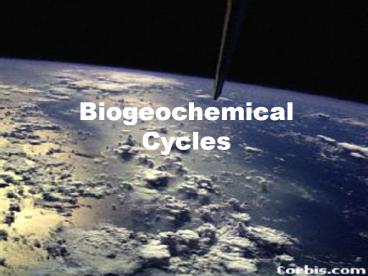Biogeochemical%20Cycles - PowerPoint PPT Presentation
Title:
Biogeochemical%20Cycles
Description:
Biogeochemical Cycles * WATER CYCLE Also called the Hydrologic Cycle Water is circulated through the global ecosystem. Fresh water evaporates and condenses back ... – PowerPoint PPT presentation
Number of Views:406
Avg rating:3.0/5.0
Title: Biogeochemical%20Cycles
1
Biogeochemical Cycles
2
WATER CYCLE
- Also called the Hydrologic Cycle
- Water is circulated through the global ecosystem.
- Fresh water evaporates and condenses back to
earth.
3
OVERVIEWWater evaporates into the atmosphere,
condenses, and falls to earth as rain, snow, or
sleet. The water then flows to the oceans to
begin the cycle again. Energy to keep the cycle
moving comes from the sun.
4
KEY PROCESSES OF THE WATER CYCLE
- Evaporation
- Transpiration
- Condensation
- Precipitation
5
EVAPORATIONOccurs when solarenergy causes
water from oceans, fresh water bodies, land, and
plants to move from the earth to the
atmosphere All impurities dissolved in water
are left behind water vapor is pure water
6
Transpiration
- The evaporation of water from leaves
7
CONDENSATION The process by which a gas
becomes a liquid Clouds form from the
condensation of water vapor
8
PRECIPITATION The process by which water
falls from clouds as rain, snow, sleet, and hail.
9
OTHER STUFF ABOUT WATER Water flows over the
land as runoff or soaks deep into the soil and
rock underground becoming groundwater. An
aquifer is an underground reservoir of fresh
water trapped by rocks.
Planet earths water system is a closed system.
Water molecules are used over and over again. No
new water molecules leave or enter the water
system.
10
BIG IDEAThe water we drink connects us with
living organisms from our distant past.This
same water will be used by organisms in the
future.
11
(No Transcript)
12
(No Transcript)
13
Critical ThinkingWater, water everywhere,
but not a drop to drink!Water covers 75 of
planet earth. The water cycle is a closed system
that returns water repeatedly to our planet. So,
water is a renewable resource. If this is true,
why is it important to conserve water?
14
The Carbon Cycle
- Basic constituent of all organic compounds (Life
!) - 760 billion tons in the atmosphere.
- 0.035 of the atmospheric elements.
15
Forms of Carbon
- Atmosphere CO2
- Living and decaying matter
- proteins and carbohydrates
- Oceans salts
- Rocks carbonate solids
- Fossil fuels
- Petroleum, hydrocarbons, and coal
16
(No Transcript)
17
Atmospheric Carbon Sources
- Carbon enters the atmosphere in many ways
- Cellular Respiration
- The decay of plant and animal matter
- The evaporation of the ocean waters
- Volcanic activity
- The burning of fossil fuels
18
Terrestrial Carbon
- Assimilation through photosynthesis by autotrophs
- Ocean reservoirs (sink)
- The weathering of rocks
- Organic matter which becomes fossil fuels.
19
CARBON CYCLE
20
Carbon Cycle
21
The Carbon Balance
- The net result of all of these interactions in
that the amount of carbon in the atmosphere
remains constant even though carbon atoms
constantly leave and enter the atmosphere as they
cycle.
22
Upsetting the Balance
- Burning of fossil fuels (6 billion tons per year)
- Deforestation (1 billion tons per year)
- The concentration of carbon in our atmosphere has
increased 25 in the last century alone!
23
(No Transcript)
24
Critical Thinking
- The increase in carbon dioxide in the
atmosphere has precipitated what scientists now
call The Greenhouse Effect. The CO2 molecules
trap the suns energy and heat as it is reflected
from the planet back towards the atmosphere. As
global temperatures continue to rise, the concern
is not with the fact that we have a greenhouse
effect, but whether human activities are leading
to an enhancement of the greenhouse effect by the
emission of greenhouse gases through fossil fuel
combustion and deforestation. Create a graph to
show how human activities could make the
temperature on our planet rise regardless of
natural temperature cycles over long periods of
time on the planet. (Hint Think slope of the
temperature line.)
25
NITROGEN CYCLE
- Overview
- Needed by organisms to make proteins
- Makes up 80 of our atmosphere
- Nitrogen (N2 ) can not be used by organisms and
must be fixed
26
NITROGEN CYCLE
27
STEPS OF THE NITROGEN CYCLE
- Nitrogen Fixation
- Nitrogen Reservoirs
- Nitrogen Release
28
NITROGEN FIXATION
Nitrogen-fixing bacteria are found in soil,
water, and the roots of some plants. Nitrogen
fixation process by which bacteria converts
gaseous nitrogen (N2) into ammonia (NH3).
29
NITRIFICATION
- bacteria take ammonia (NH3) and convert it into
nitrites (NO2-) and nitrates (NO3-)
30
NITROGEN RESERVOIRS
- Plants take in nitrates from the soil.
- Animals can obtain nitrogen by eating plants.
31
NITROGEN RELEASE
- Returned to the soil by
- Animal waste
- Decomposition of organisms
- Ammonification
- the decomposition of organic nitrogen to ammonia
32
NITROGEN RELEASE
- Returned to the atmosphere by
- Denitrification process by which bacteria
convert nitrate (NO3-) back to gaseous nitrogen
(N2).
33
Critical Thinking
- Farmers add fertilizer to their crops to increase
their yield. Extra fertilizer often is carried
in irrigation waters to rivers, streams, ponds,
and lakes nearby. What are some of the possible
outcomes for a lake ecosystem that receives the
fertilizer runoff?































